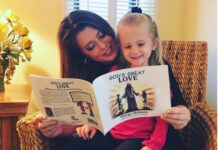By Mark Ellis

Dr. Harold Sala has been a purveyor of God’s truth and wisdom in easily accessible, bite-sized morsels for decades. In fact, the ministry he and his wife Darlene launched, Guidelines International Ministries, is celebrating their 50th anniversary this year.
The idea for his new book, What You Need to Know about Healing (B & H Publishing Group), began with a request from a remarkable nurse in Kenya known as Sister Freda, who oversees a 32-bed hospital and nursing school established with help from Guidelines. Sister Freda asked if Dr. Sala could write something that would address a biblical view of healing for use in her school’s curriculum.
His project quickly outgrew that specific appeal, as he recognized the need to tackle the issue for a broader spectrum of readers. Sadly, many Christians seem to be looking through fogged glasses when it comes to understanding the subject of healing. Some wonder if the Great Physician is still practicing today. Others have become jaded or confused by some of the extremes in the way healing is taught.
God’s sovereignty and sound doctrine form the backbone of Dr. Sala’s thoroughly biblical analysis, as he manages to strike a balance between divergent views.
As a result, Dr. Sala’s well-honed communication skills have produced a comprehensive study destined to be a classic. He lays a solid Scriptural foundation in the early chapters, establishing God’s compassion and care as Jehovah Rapha, the God who heals.
He gleans essential truths from the biblical accounts of healing, and in a scholarly fashion weaves his way through church history, carefully documenting God’s healing touch through the centuries.
Three ways God heals
Dr. Sala finds three ways God continues to heal. First, is the miraculous, which most believers long to find for themselves and their loved ones. The book examines in a careful manner many miraculous healings throughout ancient and modern times.
Secondly, God uses ‘integrative healing,’ which combines medical science, doctors, the prayers of the saints, and God’s gracious response. “The concept was advocated by the apostle Paul himself,” Dr. Sala notes, “when he told a young pastor whose name was Timothy to ‘no longer drink only water, but use a little wine for the sake of your stomach and your frequent ailments.’”
“Both the Old and New Testaments acknowledge the skills of physicians,” Dr. Sala notes. Jesus never “expressed displeasure or censured individuals who went to physicians for relief from sickness,” he observes.
The third manner God heals Dr. Sala refers to as ‘redemptive healing.’ In this instance, one suffering disease may not find physical healing, but healing on other levels, and that individual blesses the people around them in profound ways with a brighter reflection of the Lord’s presence.
Dr. Sala cites Joni Eareckson Tada, who wrote the forward for the book, as a living embodiment of redemptive healing. As a teenager in 1967, she was paralyzed in a freak diving accident. Recently she battled breast cancer and continues to suffer chronic pain. But she has no regrets, and even says she is grateful God has not healed her paralysis.
“What if I had been healed at the Kathryn Kuhlman crusade in the early 1970s? What if God had answered my prayers as a 17-year-old, released me from my paralysis, and returned me to a life of a woman on her feet?” she asks.
She would not have had the opportunity to lead many others to Christ through her ministry and to provide hope to countless sufferers facing similar challenges, she observes.
“My affliction,” she wrote, “has stretched my hope, made me know Christ better, helped me long for truth, led me to repentance of sin, goaded me to give thanks in times of sorrow, increased my faith and strengthened my character.
“If that doesn’t qualify as a miracle in your book, then—may I say in all kindness?—I prefer my book to yours.”
‘Skeptic-proof’ healing miracles
Dr. Sala documents several “skeptic-proof” examples of miracles, including a man named John Margosian, who had cancer of the pancreas, one of the deadliest forms of the insidious disease.
“The tumor, which had wrapped itself around the abdominal aorta and inferior vena cava, was inoperable,” doctors at UCLA found when they attempted surgery. Margosian was given three months to live.
The elders of Margosian’s church came to his house, anointed him with oil, and prayed for healing. He had many family and friends praying for him. He even had inmates at Chino Prison in California fasting and praying for his healing, because Margosian had spent three decades visiting the prison, ministering to them.
Several weeks later, after a bout with spinal meningitis when he came close to death, Margosian started eating and began to gain weight. When he went back for follow-up tests, doctors could find no trace of the tumor.
Dr. Sala asked Margosian’s physician, Dr. Dennis Cope, if it was a miracle. “Very definitely!” he exclaimed. “There is no human explanation for what happened.”
One of the highlights of the book is the final chapter, “What to do when you need healing.” The wisdom dispensed in this chapter alone makes the book worth having in every Christian’s library. First and foremost, Dr. Sala exhorts his readers to “stay focused on the Great Physician.”
He offers eight steps that every believer should follow in their quest for healing. “These steps are like a staircase that allows you to transcend the shackles of your pain and suffering and kneel in front of Him who loves you and will heal you His way, which may not necessarily be your way,” Dr. Sala writes.
What You Need to Know about Healing is insightful and reasonable, faith affirming and sound, a must read for anyone grappling with physical affliction who longs to find God’s healing touch.




Comments are closed.